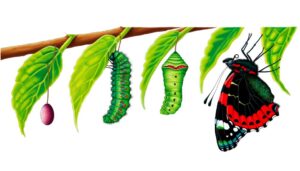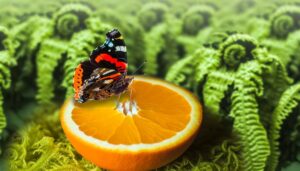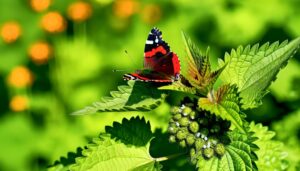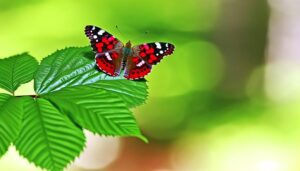Butterflies Like the Red Admiral: A Look at 5 Similar Species
Butterflies akin to the Red Admiral, such as the Painted Lady and Monarch, manifest similar migratory behaviors and ecological roles. The Painted Lady exhibits long-distance migrations and predation-avoidant wing coloration.
Meanwhile, Monarch butterflies share morphological traits including orange and black aposematic coloration for predator deterrence. These species thrive in various habitats, ranging from temperate forests to urban gardens.
Their similar feeding habits involve seeking nectar from flowers like Buddleja and Asteraceae, contributing considerably to pollination. Despite minor differences, these butterflies highlight convergent evolutionary adaptations essential for survival.
Explore further to uncover fascinating specifics of their ecological interactions.

Key Takeaways
- Painted Lady butterflies share similar migratory behaviors and habitat preferences.
- Monarch butterflies exhibit long-distance migrations and aposematic coloration like Red Admirals.
- Both Painted Lady and Red Admiral butterflies favor diverse environments, including woodlands and urban gardens.
- Monarchs and Red Admirals utilize various host plants, with nettles being preferred by Red Admirals.
Habitat and Distribution

The Red Admiral butterfly (Vanessa atalanta) inhabits a diverse range of ecological zones, including temperate forests, meadows, and urban gardens, demonstrating significant adaptability in its distribution across North America, Europe, and Asia.
This species exhibits a remarkable migratory behavior, often traveling hundreds of kilometers to exploit seasonal variations in climate and food availability.
Studies show a preference for regions with abundant host plants like nettles (Urtica spp.), critical for larval development. In urban settings, they utilize ornamental flora, which provides nectar sources.
Population density data indicates fluctuating numbers influenced by climatic conditions and habitat fragmentation.
This broad ecological plasticity underscores the species' resilience and its potential role as an indicator for environmental health assessments.
Physical Characteristics
The Red Admiral butterfly (Vanessa atalanta) exhibits distinct wing color patterns characterized by striking red bands and white spots on a mainly black background, facilitating species identification and predator avoidance.
Its body size averages between 5 to 6 centimeters in wingspan, with a robust, dorsoventrally flattened body that supports agile flight maneuvers.
Morphometric analyses reveal a streamlined shape, contributing to its migratory capabilities and thermoregulation efficiency.
Wing Color Patterns
Among the striking physical characteristics of the Red Admiral Butterfly (Vanessa atalanta), its wing color patterns stand out due to their distinct combination of vibrant red bands and dark, velvety brown hues.
The forewings exhibit prominent red-orange bands that contrast sharply with the mainly black-brown background, while the hindwings feature marginal white spots and subtle blue markings near the edges.
This coloration is not merely aesthetic; it plays a vital role in thermoregulation and predator avoidance.
According to entomological studies, the red bands are highly reflective in ultraviolet light, making the butterfly less visible to predators. The dark pigments, primarily melanin, absorb sunlight, aiding in temperature regulation.
These patterns exemplify evolutionary adaptations for survival and ecological interactions.
Body Size and Shape
In addition to their vivid wing patterns, Red Admiral Butterflies exhibit a robust body structure with an average wingspan ranging from 45 to 50 millimeters, highlighting their medium size within the Nymphalidae family. The body is characterized by a compact, slightly tapered abdomen, and a thorax that supports strong, elongated legs adapted for clinging to various surfaces. The head features prominent compound eyes and antennae tipped with small clubs, essential for navigation and sensory perception.
| Characteristic | Measurement/Description | Functionality |
|---|---|---|
| Wingspan | 45-50 mm | Aids in medium-range flight |
| Abdomen | Compact, slightly tapered | Supports critical organs |
| Thorax | Robust with elongated legs | Provides stability and movement |
| Antennae | Club-tipped | Enhances sensory capabilities |
These attributes collectively contribute to their adept survival and adaptability in diverse habitats.
Life Cycle Stages
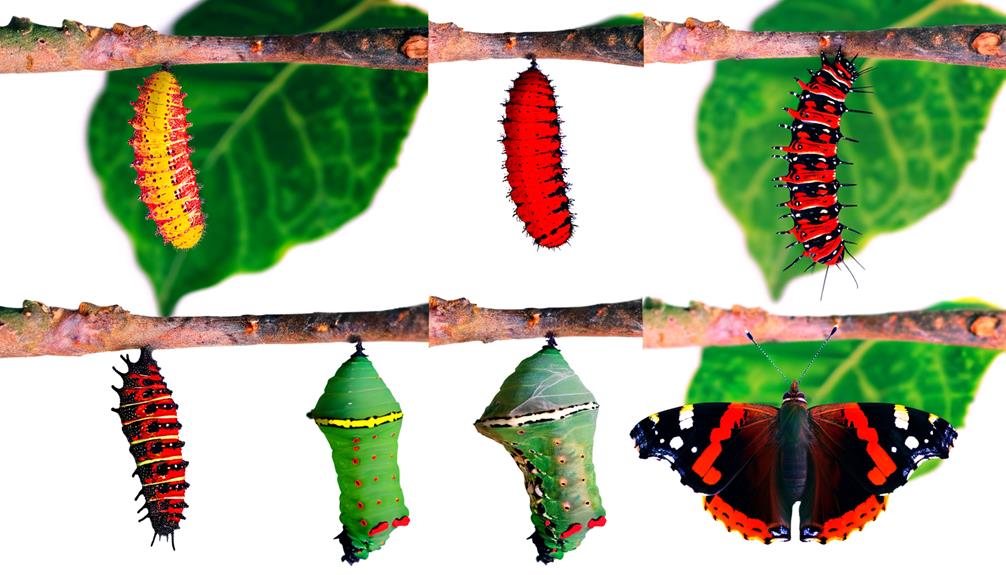
Four distinct stages define the life cycle of the Red Admiral butterfly, each characterized by unique physiological and developmental changes.
Beginning with the oviposition of eggs on host plants, the embryonic stage spans approximately 3-5 days.
Larvae emerge, exhibiting polymorphic coloration and undergo five instar phases, each marked by molting and growth. This larval period lasts around 2-3 weeks.
Subsequently, pupation occurs within a chrysalis, a transformative phase lasting about 1-2 weeks, wherein metamorphosis transpires. Detailed observations reveal drastic morphological reconfigurations during this stage.
Finally, the adult butterfly emerges, fully developed with distinctive wing patterns, ready for reproduction.
This intricate life cycle, meticulously timed, guarantees the survival and propagation of the Red Admiral species.
Feeding Habits
The Red Admiral butterfly (Vanessa atalanta) exhibits a preference for nectar from flowering plants such as Buddleja and Asteraceae, which provide essential nutrients for adult sustenance.
Seasonal variations influence their feeding patterns, with a marked increase in nectar consumption during migration periods in spring and autumn.
Additionally, their feeding activities contribute considerably to the pollination of various plant species, enhancing ecological interactions within their habitats.
Preferred Nectar Sources
Red Admiral butterflies exhibit a strong preference for nectar from flowering plants such as Buddleja, commonly known as butterfly bush, due to its high sucrose concentration and prolonged blooming period.
Studies have shown that the Red Admiral (Vanessa atalanta) frequently visits Buddleja, which provides a consistent and abundant source of energy essential for their metabolic needs.
Additionally, they are attracted to other nectar-rich sources like Aster, Echinacea, and Verbena.
Empirical data indicate that these butterflies tend to select flowers with high nectar volumes and sugar concentrations, optimizing their foraging efficiency.
The correlation between nectar availability and butterfly visitation underscores the importance of floral biodiversity in supporting Red Admiral populations.
Seasonal Feeding Patterns
During the warmer months, Vanessa atalanta demonstrates distinct seasonal feeding patterns characterized by heightened activity and increased nectar consumption.
Observations indicate a marked preference for high-sugar nectar sources such as Buddleja davidii and Lantana camara. This increased intake aligns with the butterfly's need for elevated energy levels to support reproductive activities and long-distance migrations.
Data collected from field studies reveal that nectar consumption can surge by up to 40% during peak summer periods. Additionally, the Red Admiral exhibits a behavioral shift towards feeding in early morning and late afternoon, possibly to avoid midday heat stress.
These adaptations are essential for optimizing nutrient intake and ensuring survival during periods of heightened metabolic demand.
Role in Pollination
While seasonal feeding patterns underscore the necessity for energy intake, Vanessa atalanta's feeding habits also play a significant role in pollination ecology, facilitating cross-pollination of various angiosperms through their consistent foraging behaviors.
Observational studies have documented that Red Admirals exhibit high floral fidelity, frequently visiting nectar-rich flowers such as Buddleja davidii and Asteraceae species. This behavior enhances pollen transfer efficiency.
Their proboscis morphology allows them to access deep floral nectaries, effectively transporting pollen grains between flowers. Data indicate that Vanessa atalanta contributes to the reproductive success of over 20 plant species.
This mutualistic interaction underscores the butterfly's ecological importance, highlighting its role in maintaining biodiversity and ecosystem stability.
Role in Pollination

In their role as pollinators, Red Admiral butterflies (Vanessa atalanta) greatly contribute to the reproductive success of various flowering plants by transferring pollen as they feed on nectar.
These butterflies exhibit a preference for nectar-rich plants, such as Buddleja and Echinacea, which they visit frequently.
Observations indicate that their proboscis length, approximately 12-15 mm, is well-suited for accessing deep floral nectaries.
By moving between flowers, Red Admirals facilitate cross-pollination, promoting genetic diversity within plant populations.
Studies have shown that their pollination activities markedly enhance seed set and fruit yield in plants like nettles and thistles.
This mutualistic interaction underscores the ecological importance of Red Admirals in maintaining plant biodiversity and ecosystem health.
Seasonal Behaviors
Red Admiral butterflies (Vanessa atalanta) exhibit distinct seasonal behaviors, which are intricately linked to their migratory patterns and reproductive cycles.
During the spring and summer, they migrate northwards from southern regions, driven by favorable temperatures and abundant food sources. Migration data indicate that they travel distances up to 2,000 kilometers.
Reproductive activity peaks during these warmer months, with females laying eggs primarily on nettles (Urtica spp.).
In autumn, these butterflies reverse their migration to evade colder climates. Behavioral observations reveal a marked decrease in activity during winter, often entering a state of diapause to conserve energy.
These seasonal behaviors enhance their survival and reproductive success, demonstrating a finely tuned adaptation to environmental cues and resource availability.
Threats and Conservation

The Red Admiral butterfly faces numerous threats, including habitat loss, climate change, and pesticide exposure, which critically impact their populations and necessitate targeted conservation efforts.
Habitat fragmentation reduces the availability of host plants like nettles, essential for larval development. Climate change disrupts migratory patterns and timing, leading to mismatches in food availability. Pesticide exposure results in direct toxicity and sublethal effects, such as impaired reproduction and reduced fitness.
Effective conservation strategies include:
- Habitat restoration: Re-establishing native plant communities to support all life stages.
- Climate resilience: Implementing measures to mitigate and adapt to climate change impacts.
Focused conservation initiatives can help stabilize and potentially increase Red Admiral populations.
Similar Species
The Red Admiral Butterfly (Vanessa atalanta) shares numerous morphological and behavioral traits with the Painted Lady (Vanessa cardui) and the Monarch Butterfly (Danaus plexippus).
Both the Painted Lady and the Red Admiral exhibit similar wing coloration patterns, including striking orange and black hues, though subtle differences in wing spots and size can be observed with close examination.
Additionally, migratory behaviors and habitat preferences align closely between the Red Admiral and Monarch, with both species demonstrating long-distance migrations influenced by seasonal changes.
Painted Lady Comparison
Among the myriad similarities between the Red Admiral butterfly (Vanessa atalanta) and the Painted Lady butterfly (Vanessa cardui) are their migratory behaviors and adaptive coloration patterns, which have been extensively documented in various lepidopterological studies.
Both species exhibit long-distance migration, with the Painted Lady traveling from North Africa to Europe and the Red Admiral from North America to Central America.
Their wing coloration, designed for both predation avoidance and mating, features intricate patterns that serve as camouflage and warning signals.
- Migratory routes: Both butterflies undertake impressive seasonal migrations.
- Adaptive coloration: Their wing patterns exemplify evolutionary adaptations.
These characteristics underscore their evolutionary success and ecological versatility.
Monarch Butterfly Similarities
Red Admiral butterflies exhibit several notable similarities to Monarch butterflies (Danaus plexippus), particularly in their migratory behavior and ecological interactions.
Both species undertake extensive migrations, with Red Admirals traveling from northern Europe to the Mediterranean, while Monarchs migrate from North America to central Mexico.
Ecologically, both butterflies utilize a range of host plants; Red Admirals prefer nettles (Urtica dioica), whereas Monarchs depend on milkweed (Asclepias spp.) for larval development.
Additionally, both species exhibit aposematic coloration as an anti-predatory strategy, warning potential predators of their unpalatability.
These shared traits underscore the adaptive strategies employed by both butterflies to survive across diverse, and often challenging, environments.
Such similarities highlight convergent evolutionary pathways among Lepidoptera.
Attracting Them to Your Garden

Creating an inviting habitat for the Red Admiral butterfly entails incorporating specific nectar-rich plants and maintaining an environment that supports their life cycle stages. These butterflies favor gardens with a variety of flowering plants that provide abundant nectar sources.
Key plants include:
- Buddleia (Butterfly Bush): Offers high nectar content, attracting numerous butterflies.
- Nettle (Urtica dioica): Essential for larval development, providing a host for egg-laying and caterpillar feeding.
Ensuring a continuous supply of nectar through various blooming seasons and minimizing pesticide use are critical.
Additionally, providing sunlit areas and water sources enhances the habitat, fostering a conducive environment for the Red Admiral's complete life cycle.
Fun Facts
One fascinating aspect of the Red Admiral butterfly (Vanessa atalanta) is its remarkable migratory behavior, which involves traveling vast distances across continents. These butterflies migrate from North Africa and Southern Europe to Northern Europe, covering distances up to 3,000 kilometers.
Another intriguing fact is their ability to fly at speeds of up to 30 km/h. Red Admirals are also known for their territoriality; males often engage in aerial battles to defend their chosen perches.
Additionally, their diet is not limited to nectar; they are also attracted to fermenting fruit and tree sap. This dietary flexibility aids their survival in diverse habitats.
Conclusion
In summary, the red admiral butterfly exhibits distinct habitat preferences, marked by its widespread distribution and notable physical characteristics. These butterflies thrive in diverse environments, including woodlands, gardens, and meadows, where their preferred host plants, such as nettles, are abundant. Their adaptability to various climates and ability to migrate long distances contribute to why red admiral butterflies are abundant in many regions. Additionally, their striking black, orange, and white coloration provides effective camouflage and deterrence against predators, further supporting their survival.
The life cycle stages, from egg to adult, reveal intricate biological processes, while feeding habits demonstrate reliance on specific host plants.
The species plays a vital role in pollination, yet faces threats necessitating conservation efforts.
Comparisons with similar species highlight unique traits.
Encouraging their presence in gardens can support ecological balance.
Data underscore the importance of targeted conservation strategies.


